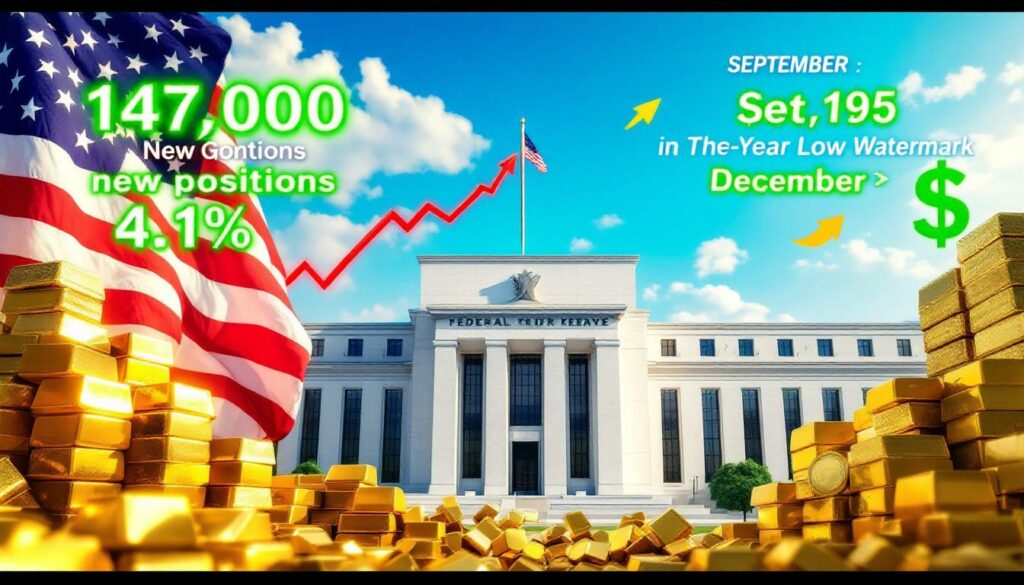What Does the Latest US Jobs Report Reveal About the Economy?
The June 2023 employment statistics have provided a clearer picture of the US economic landscape, with significantly stronger numbers than market analysts anticipated. According to the latest data, the economy added 147,000 jobs in June, substantially exceeding forecasts and demonstrating remarkable resilience despite ongoing economic uncertainties.
The unemployment rate has decreased to 4.1%, continuing a downward trend that signals fundamental strength in the labor market. This decline is particularly noteworthy given the Federal Reserve's monetary tightening cycle that has been in effect for much of the past year.
"The job market's holding there despite higher interest rates, which is reducing the urgency for immediate rate cuts," notes Russell Shaw, Senior Market Analyst at trading.com. "This resilience suggests underlying economic momentum that many weren't expecting."
Key Economic Indicators and Their Significance
The recent job growth exceeding forecasts carries significant implications for economic outlook. When employment outperforms expectations, it typically signals businesses remain confident enough to continue hiring despite higher borrowing costs and economic headwinds.
The decreasing unemployment rate further reinforces the narrative of labor market stability. At 4.1%, this rate remains historically low, indicating a tight labor market where employers are competing for workers, which traditionally supports wage growth and consumer spending.
Wage growth data from the report provides critical insights into potential US Economy Inflation Outlook. While the labor market remains strong, wage increases have moderated somewhat from their post-pandemic peaks, suggesting that some inflation pressures may be easing without triggering a substantial rise in unemployment.
Labor force participation rates represent another vital metric within the report, reflecting overall workforce engagement. Recent trends show modest improvements in participation, indicating that previously sidelined workers are gradually returning to the job market, which could help ease hiring difficulties without accelerating wage inflation.
How Will the Jobs Report Impact Federal Reserve Interest Rate Decisions?
The stronger-than-expected employment data has dramatically shifted market expectations regarding Federal Reserve policy. According to market analysts, the probability of a July interest rate reduction has effectively been eliminated following the jobs report today.
"What this robust employment data does is remove any chance of a July rate cut," explains Shaw. "The September cut probability has also scaled back somewhat, though it remains the likely first move in the cycle."
The jobs report's strength suggests the Fed can afford to be patient with rate cuts, particularly as they monitor inflation trends through the summer months.
Current Federal Reserve Policy Trajectory
Despite the delay in immediate action, market consensus still anticipates two potential rate cuts for the remainder of the year. Financial markets have adjusted their expectations to focus on September and December as the most likely timeframes for these policy adjustments.
"The path of least resistance is two cuts this year," Shaw notes. "But the timing is increasingly data-dependent, and the Fed is signaling that this data dependency is their wisest path forward."
This approach represents a significant shift from earlier in the year when markets had priced in as many as six or seven rate cuts. The Federal Reserve's current stance emphasizes patience and data analysis over predetermined policy schedules.
Inflation Concerns and Rate Cut Timing
A critical factor complicating rate cut decisions is the potential for inflation to increase during the July-August period. This seasonal pattern has been observed in previous years and remains a concern for monetary policymakers.
"There is a real scare that inflation will pick up over July into August," warns Shaw. "The Fed remains cautious about cutting rates amid potential inflation resurgence, especially given their hard-won credibility in fighting price pressures."
The Federal Reserve must carefully balance multiple competing objectives: supporting economic growth, maintaining employment, and ensuring price stability. This balancing act becomes particularly challenging when strong employment data coincides with persistent inflation concerns.
What's Happening with the US Dollar and Its Global Impact?
The US dollar has experienced a period of historic weakness, reaching a three-year low against a basket of major currencies. According to financial analysts, this represents the worst first six months performance in 50 years (since 1973), marking a significant shift in currency markets.
This dollar depreciation comes despite relatively strong economic data, suggesting other factors are driving currency valuations beyond traditional economic fundamentals.
Factors Driving Dollar Depreciation
Several key factors have contributed to the dollar's weakness. Uncertainty surrounding US trade policies has created volatility in currency markets, with investors concerned about potential disruptions to global commerce and supply chains.
Presidential rhetoric has also played a role in the currency's valuation. "President Trump does tend to talk the dollar down," observes Shaw. "This rhetoric, potentially aimed at boosting US exports, has contributed to downward pressure on the currency."
Tensions between White House and Federal Reserve leadership have further complicated the situation. "The antagonism between the administration and the central bank weakens the dollar further," Shaw explains. "Markets dislike uncertainty in monetary policy coordination."
Market anticipation of future interest rate reductions has likewise pressured the dollar. As investors price in potential rate cuts, the interest rate differential between the US and other developed economies narrows, reducing the dollar's yield advantage.
Economic Implications of a Weaker Dollar
A weaker dollar creates both opportunities and challenges for the US economy. American exports become more competitively priced in international markets, potentially boosting manufacturing and agriculture sectors that rely heavily on overseas sales.
However, dollar depreciation can introduce inflationary pressures through higher import costs. When the dollar weakens, imported goods become more expensive for American consumers and businesses, potentially contributing to broader price increases throughout the economy.
The currency's movements also impact international trade balances and global currency markets. A weaker dollar can lead to shifts in capital flows, affecting everything from developing economy debt servicing to commodity market volatility worldwide.
US purchasing power in global markets diminishes with dollar weakness, affecting American companies with international operations and consumers purchasing imported goods.
How Are Precious Metals Responding to Economic Conditions?
Precious metals, particularly gold, have shown remarkable strength in recent months, supported by several key factors including central bank purchasing and geopolitical uncertainties.
Gold Market Analysis
"Central bank purchasing has been a consistent underpinning of the gold market," Shaw explains. "This institutional buying provides a floor for prices even during temporary market fluctuations."
Following the strong jobs report, gold experienced a temporary price dip as markets adjusted rate cut expectations. This reaction demonstrates the metal's sensitivity to interest rate forecasts, as gold typically performs better in lower-rate environments due to its non-yielding nature.
The inverse relationship between dollar strength and gold prices analysis continues to influence valuations. As the dollar weakens, gold becomes less expensive for buyers using other currencies, potentially increasing demand and supporting higher prices.
Gold's traditional appeal during periods of economic uncertainty remains intact. "Diplomatic tensions and dollar weakness create strong undercurrents supporting gold," notes Shaw. Investors often turn to precious metals when seeking alternatives to currency-based assets during uncertain economic conditions.
Silver Market Dynamics
Silver has displayed interesting correlation patterns with gold prices, though with distinct characteristics. "Silver has been playing catch-up after lagging behind gold for quite some time," Shaw observes. "We're seeing it moving more in tandem now."
Recent performance indicates silver has been gaining momentum after underperforming relative to gold earlier in the year. This catch-up pattern often occurs in precious metals markets, with silver typically experiencing more volatility due to its smaller market size.
Silver presents a unique value proposition for investors seeking alternatives to gold. Its lower price point per ounce makes it accessible to more investors, while its industrial applications provide additional demand drivers beyond investment interest.
The dual nature of silver demand—combining both investment interest and industrial applications in electronics, solar panels, and medical devices—creates a distinct market dynamic compared to gold.
Gold-Silver Ratio Implications
The gold-silver ratio (the number of silver ounces required to purchase one ounce of gold) offers insights into relative valuations between the metals. Historical patterns show this ratio tends to contract during strong precious metals bull markets.
"April tariff announcements created notable distortions in the gold-silver ratio," Shaw points out. This demonstrates how policy decisions can temporarily disrupt typical market relationships before eventual normalization.
Trading strategies based on relative valuations often involve monitoring this ratio for potential mean reversion opportunities. When the ratio reaches historical extremes, some traders position for a potential correction.
Market analysts anticipate potential future convergence in price movements between gold and silver, particularly if industrial demand increases alongside investment interest.
What Are Expert Predictions for US Interest Rates?
Expert consensus has coalesced around specific expectations for the Federal Reserve's interest rate path through the remainder of the year.
Federal Reserve's Likely Rate Path
Financial markets are currently pricing in two rate cuts projected for the remainder of the year, with September and December emerging as the most probable adjustment periods.
"September and December are now the focus for potential policy adjustments," Shaw confirms. "The market has adjusted its expectations significantly from earlier this year."
The Federal Reserve's increasingly data-dependent approach means each economic release will be scrutinized for its implications on monetary policy. This approach allows the Fed flexibility to respond to changing economic conditions rather than committing to a predetermined schedule of rate adjustments.
Economic Factors Influencing Rate Decisions
The strong labor market has reduced urgency for immediate cuts, giving the Federal Reserve room to maneuver. With unemployment at 4.1% and job creation exceeding expectations, the US economy and job report shows few signs of immediate distress requiring emergency monetary accommodation.
Inflation concerns continue to temper aggressive rate reduction plans. "The Fed is highly sensitive to any signs of persistent inflation," Shaw notes. "They won't rush to cut rates if price pressures remain above their comfort zone."
The delicate balance between supporting economic growth and preventing overheating remains the central challenge for monetary policymakers. Cut rates too quickly, and inflation might accelerate; wait too long, and economic momentum could falter.
Political vs. Economic Considerations
Presidential pressure for rate cuts has introduced political dimensions to what are traditionally technocratic decisions. "There's clear tension between political desires for lower rates and the Fed's mandate for economic stability," observes Shaw.
Market expectations create additional challenges for policy communication, as Federal Reserve officials must manage investor anticipations without committing to specific policy paths that might later prove inappropriate as conditions evolve.
The tension between long-term economic stability and short-term political objectives highlights the importance of central bank independence. The Federal Reserve's credibility depends on its ability to make policy decisions based on economic data rather than political pressures.
How Might These Economic Indicators Affect Investment Markets?
The complex interplay of employment data, interest rate expectations, and currency movements creates diverse implications across investment markets.
Equity Market Implications
Strong job growth fundamentally supports corporate earnings potential by underpinning consumer spending, which drives approximately 70% of US economic activity. Companies with significant domestic exposure may benefit particularly from a resilient labor market.
Interest rate expectations heavily influence sector rotations within equity markets. As rate cut forecasts adjust, capital often flows between growth-oriented sectors (like technology) and value-oriented sectors (like financials and utilities), creating opportunities for tactical positioning.
Dollar weakness affects multinational corporation profits in complex ways. While it can boost overseas earnings when translated back to dollars, it may also increase input costs for companies reliant on imported materials or components.
Bond Market Outlook
Yield curve adjustments based on rate cut expectations have significant implications for fixed-income investors. As markets price in potential rate cuts, longer-dated Treasuries often experience price appreciation, while yield spreads between different maturities adjust to reflect changing economic expectations.
Fixed income valuations respond directly to economic data, with stronger-than-expected employment figures typically pressuring bond prices lower (and yields higher) as investors reduce expectations for aggressive rate cuts.
Treasury market positioning ahead of potential policy shifts requires careful consideration of duration risk, yield curve steepness, and inflation expectations. Investors must balance current yield opportunities against potential capital appreciation or depreciation as monetary policy evolves.
Commodity Investment Considerations
Dollar-denominated commodities benefit from currency weakness, as lower dollar values make these assets less expensive for buyers using other currencies. This relationship is particularly evident in precious metals, energy, and agricultural markets.
"Dollar weakness creates a supportive environment for commodity prices broadly," Shaw explains. "This effect is amplified for commodities with tight supply-demand fundamentals."
Precious metals continue to serve as portfolio diversification tools, particularly during periods of currency volatility and geopolitical uncertainty. Their historically low correlation with traditional financial assets makes them attractive for risk management purposes.
Industrial commodities respond to economic growth signals, with materials like copper, aluminum, and lumber often serving as barometers for construction activity and manufacturing output. The strong employment data suggests continued demand for these economically sensitive commodities.
FAQ: Understanding the US Economic Outlook
How do employment reports influence Federal Reserve decisions?
Employment reports provide critical insights into labor market health, wage pressures, and overall economic activity. Strong job growth typically reduces the urgency for accommodative monetary policy, while weakening employment data often encourages rate cuts to stimulate economic activity.
The Federal Reserve closely analyzes these reports alongside inflation data to balance its dual mandate of maximum employment and price stability. Particular attention is paid to wage growth metrics, as these can signal potential inflationary pressures developing within the labor market.
Beyond headline numbers, the Fed examines labor force participation rates, the quality of jobs being created, and the distribution of employment gains across economic sectors to form a comprehensive view of labor market conditions.
Why does dollar weakness benefit commodity prices?
When the US dollar weakens, commodities priced in dollars become less expensive for buyers using other currencies, potentially increasing demand. This price effect can be particularly significant for globally traded commodities like oil, gold, and agricultural products.
Additionally, as the purchasing power of the dollar declines, investors often seek alternative stores of value in hard assets like precious metals and commodities, further driving price appreciation. This relationship explains why commodity prices and the dollar typically move in opposite directions.
The inverse relationship between dollar strength and commodity prices is particularly evident in gold and oil markets, where currency effects can sometimes outweigh fundamental supply-demand factors in determining short-term price movements.
What economic indicators should investors monitor in the coming months?
Investors should closely track inflation reports (CPI and PCE), employment data, consumer spending patterns, manufacturing activity, housing market metrics, and Federal Reserve communications. These indicators collectively provide insights into economic momentum, potential policy shifts, and market direction.
Particular attention should be paid to wage growth data as it may signal future inflation pressures and impact Fed policy decisions. The relationship between wage increases and productivity gains will be especially important in determining whether labor costs are likely to feed through to broader price increases.
Beyond domestic indicators, international developments—including central bank policies in Europe and Asia, global trade data, and Trump tariff impacts—will increasingly influence US markets through their effects on currency values, commodity prices, and risk sentiment.
Market participants should also monitor consumer sentiment and retail sales data for early signals of changing consumption patterns that could affect corporate earnings and economic growth forecasts. Furthermore, understanding the tariffs investment impact will be crucial for investors navigating these complex market conditions.
Want to Stay Ahead of the Next Market-Moving Mineral Discovery?
Discovery Alert's proprietary Discovery IQ model delivers real-time notifications on significant ASX mineral discoveries, transforming complex data into actionable investment insights before the broader market catches on. Explore why major mineral discoveries can lead to exceptional returns by visiting our dedicated discoveries page and begin your 30-day free trial today.




